| Pratt
Rocks
|
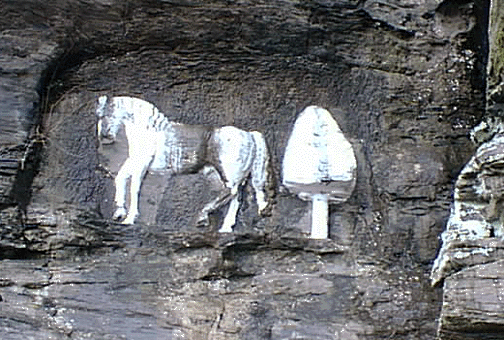
|
New York's
Mt.Rushmore, (The Guide, October 1996, by Carolyn Bennett)
Ripley's "Believe it or Not" called it "New York's Mt.Rushmore.
Another, less generous appraisal termed it "a monument to vanity". Pratt
Rock Park, by the side of Route 23 on the outskirts of Prattsville, like many other points
of interest in the Catskill Mountains, seems to attract widely varying opinions. And
its story, like the Catskills themselves, is cloaked in legend.
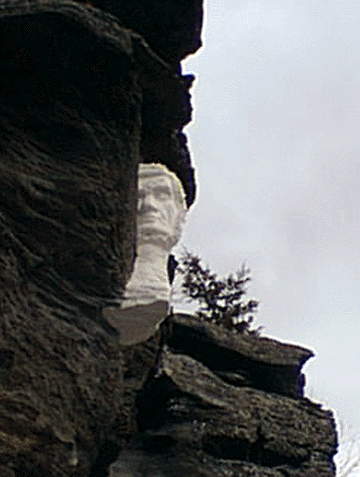 |
|
The story goes that a poor stonecutter passing through the village of
Prattsville in 1843 panhandled the town's foremost citizen, wealthy
landowner/entrepreneur/statesman Zadock Pratt, who was known for his largess. But
Pratt was also known for his belief in the salutary effects of hard work, and in return for
his modest donation (reportedly fifty cents), set the man to work carving the Abraham
Lincoln-ish profile of Pratt high above the village in the town. The poor stonecutter
must have wished he had hit someone else for four-bits. Pratt liked the stonecutter's
work so well (the story goes), and his vanity was tickled by his likeness now presiding
over the fertile valley of the Schoharie Kill, that he retained the stonecutter to carve
emblems depicting Pratt's life's story in the rock surrounding his profile: a horse and a
hemlock tree (key resources in the building of the Pratt leather-tanning |
fortune), the tannery itself (with the legend ONE
MILLION SIDES OF SOLE LEATHER TANNED WITH HEMLOCK BARK, IN TWENTY YEARS BY Z.PRATT),
the Pratt coat of arms with the motto
| DO WELL AND DOUBT NOT,
and a wreath containing the names of two of his children, George W. and Julia H. (a third
child, unmemorialized in rock, had died in infancy). The wreath originally
contained the hopeful blessing: LET VIRTUE BE YOUR
GREATEST CARE/AND STUDY YOUR DELIGHTS/SO WILL YOUR DAYS BE EVER FAIR/AND PEACEABLE YOUR
NIGHTS. |
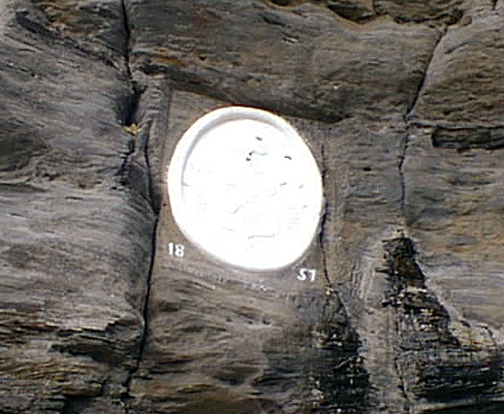 |
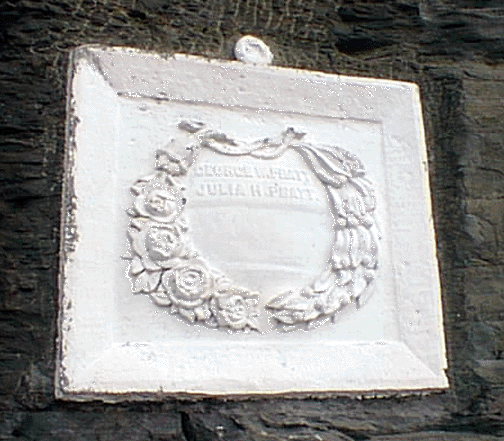 |
The verse was later removed, sometime after George was slain in 1862 by Confederate
cannon fire at the second battle of Manassas (Bull
Run).
Go to Top
Destroyed, along with George, in that rebel fusillade, were the elder Pratt's dreams of
turning over his vast commercial (almost baronial) empire to his son and heir.
Whether the relief sculptures of Pratt Rock began as a result of the whimsy of the moment,
a chance encounter with an itinerant stonecutter, or whether they had been planned for
years as a monument to himself by a man who had already imprinted his name on a village
and a township, the rocks, with George's death, became a father's memorial to a dead son.
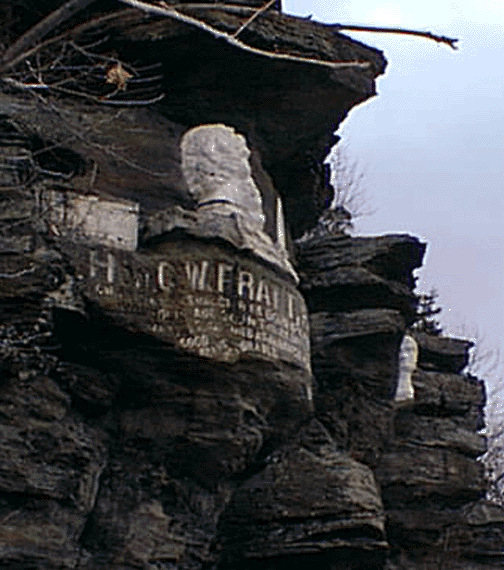 |
Under the bust of Zadock, is the brief legend, ZADOCK PRATT/BORN OCT 30, 1790,
while George was
given much more copy: HON.G.W.PRATT, Ph.D./COLXX
Regt.,N.Y.S.M., ULSTER Co., BORN APR.18 1830/WOUNDED AUG.30, IN THE 2nd BATTLE
OF/MANASSAS, VA. DIED AT ALBANY, N.Y. Sep.11TH/GOOD BRAVE HONORABLE 1862.
The verse blessing (now painfully inappropriate) was removed from the
sandstone wreath, and a large heroic bust of George was carved just to the left of the
earlier, smaller, bust of Zadock. Under the bust of Zadock, is the brief legend,
ZADOCK PRATT/BORN OCT 30, 1790, while George
was given much more copy: HON.G.W.PRATT, Ph.D./COLXX
Regt.,N.Y.S.M., ULSTER Co., BORN APR.18 1830/WOUNDED AUG.30, IN THE 2nd BATTLE
OF/MANASSAS, VA. DIED AT ALBANY, N.Y. Sep.11TH/GOOD BRAVE HONORABLE 1862. |
George was a boy of 13 when the sculptures were begun. No doubt the elder Pratt
often took his son to the park to watch the familiar features of his father, a horse, a
tree and the tannery that defined his small world in Prattsville form like magic from the
featureless gray rock. No doubt, also, the elder Pratt would tell his son how his
accomplishments also (and his son's after him) would one day be carved in the rocks to
testify to their adherence to doing well and doubting not.
| The pact was sealed, George did well (a doctorate and a Union
colonelcy), and he doubted not, as he left for Washington and points south at the head of
a regiment of militia. Afterwards, his father duly commissioned George's vital
statistics carved in the rocks where their sandstone images look at each other for
eternity. Between them was carved an uplifted right hand and the motto:
THIS HAND FOR MY COUNTRY. There are
other carvings in Pratt Rock Park (including one of an arm raising a hammer, not unlike
the baking soda emblem, perhaps an anonymous stonecutter's memorial to himself ?), but the
father and son tableau holds center court. |
|
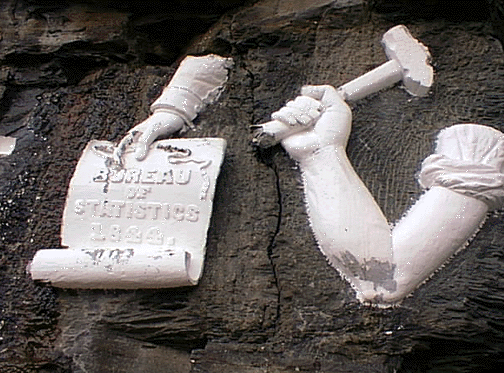 |
There is even a small recessed chamber at path level by the cliff, carved as a tomb for
Zadock. That idea was abandoned, it is said, because the stonecutter found the task
too difficult, and water leached into the chamber. But perhaps as the years
progressed and the rocks became more of a memorial to George than to Zadock, the surviving
Pratt stepped out of the spotlight and chose conventional interment in the village's
Benham Cemetery.
Go to Top
A dynasty-in-the-making died with Zadock a few years later in 1871. He had come
to the western Catskills as a small boy in the early years of the 19thy century. He
worked hard, saved his money, and built from scratch a huge tanning business which made
him very wealthy in just 20 years. Then he retired from tanning to pursue various
other commercial enterprises, squire about his grand 350-acre farm, and campaign for
public office (which he did successfully, including two productive terms in Congress).
The family fortune was made, the family was well connected and esteemed, and the heir
apparent was groomed and educated for great things, but the war that could have launched a
formidable political career for a conquering hero of the Republic, had George survived,
instead brought down the House of Pratt like a house of cards. George was just one
more casualty of a brutal war, and Zadock became a footnote to history.
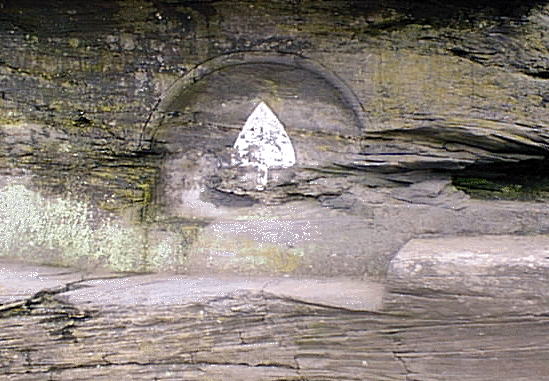 |
Pratt Rock Park is open to the public every day, and there is
no admission fee. The climb to the rocks is steep, and may be unfit for young
children, but the path is clear and ascends in a series of gently graded inclines to the
carved cliff wall 500 feet above the road. The stonecutters hacked chairs and
benches out of the rocks along the way, and picnicking is permitted, so take your time and
enjoy the ascent in a relaxed and thoughtful manner. The sculptures and the view of
the valley make the short climb more than worth the effort. For more information, call
518-299-3395, or visit the Pratt Museum in the center of town,
on Main Street in Prattsville. |
Go to Top
ON THE ROCKS - Woodstock Times,
October 24, 1996, by Robert Titus titus@hartwick.edu
Name that tomb
Prattsville, along the banks of the Schoharie River, is steeped in Catskill History.
It's emblematic of the most progressive aspects of the area's story, and at the
same time, it represents many of the mistakes people made as our region developed.
Zadock Pratt was the towering personality in the town's
development. Even today his influence permeates the village. Pratt was the
founder of the Catskill tanning industry. From 1833 to 1846 his Prattsville
tanneries turned out shoe leather for the New York City market. His tanneries,
however, were dependent upon the bark of the hemlock tree, and when the trees were all cut
down, the industry closed.
We frown upon the wanton destruction of the Catskill hemlocks that characterized the
19th century, but our collective wisdom is based upon a history of trial and error.
It was men such as Pratt who provided the errors.
Pratt is also remembered for progressive attitudes toward urban planning. His
Prattsville was a pioneering model in that field. he laid out streets, built the
Greek Revival homes and planted the 1,000 trees that lined the village streets.
Pratt founded churches and the town's academy, as well. Prattsville today is still
truly Pratt's town.
Zadock Pratt was a great man, but I suspect history would have mostly
forgotten him except for the one singular act of vanity he was responsible for.
Pratt, the Rameses II of the Schoharie, is remembered for Pratt Rock, his would-be tomb.
Pratt Rock consists of a series of stone carvings on a glacially plucked cliff along
state Route 23, just east of town, and overlooking the old Pratt farm. The site is
now a town park and open to visitors. You can hike the winding path up the steep
slope toward the main carvings. If you tire along the way you can sit upon stone
seats thoughtfully carved into the mountain. |
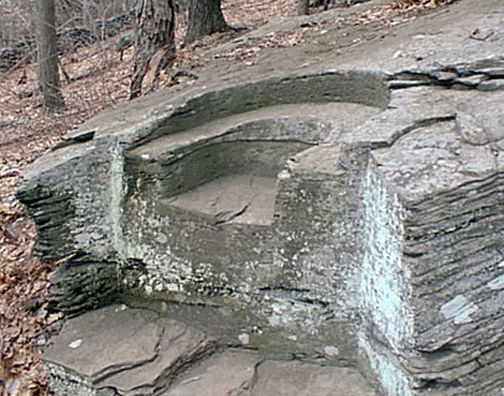 |
The main level of carvings displays images and symbols of Pratt's life. These are
carvings of the hemlock tree, a horse which hauled the bark to the tanneries, a strong arm
to do the work and other emblems of the great man's life. There is a bust of Pratt
and a poignant carving of his only son, who died in the Civil War. then there is the
Pratt burial chamber itself.
Go to Top
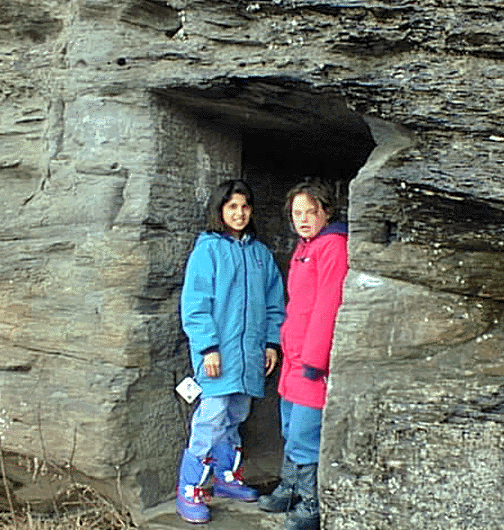
|
Unlike the pharaoh, Pratt was never buried in the grotto carved out for
him. One story is the chamber was unsuitable for burial as it leaked water when it
rained. The chamber is still there, and when I looked it over, I found there may be
some truth to that tale, along with a good geological story about Pratt Rock. Pratt Rock
is carved into sedimentary strata from the old Catskill delta. Deposited nearly 400
million years ago, the sediments here record the coastal regions of a delta similar to
that of the Mississippi River today. This was once the coastline of the old Catskill
Sea. Rivers flowed across this location and poured their waters into the old ocean.
Go to Top |
There is a lot of history here. I had little trouble finding bits and pieces of
the old Gilboa forest, and I could picture its foliage along the old stream banks.
But the most interesting horizons I found were those at the burial chamber. The
ceiling of the chamber is made up of inclined strata. This horizon of rock formed on
the sloping floor of an old stream channel. the beds slope down to the right, which
was once one side of a river, and farther along the outcrop they rise up again on the
other shore.
| When I looked at the chamber ceiling I found a horizon rich in a hash of
broken plant remains. This stratum is likely very porous and it's quite possible
this accounts for the leakage that caused the burial project to be abandoned. The
pharaohs of arid Egypt faced no such problem. An so this is one of the many ironies of
geology. The great Zadock Pratt is buried in a nearby graveyard with all the other
common folk of old Prattsville. That may be because about 370 million years ago some
small river made a wrong turn. It's not Pratt buried in Pratt's tomb, but the sands
of an ancient river! |
 |
 Home
Go to Top
Home
Go to Top
|
[Pratt Museum/prattmuseum.com/bottomlinks.htm]
|
|
|










